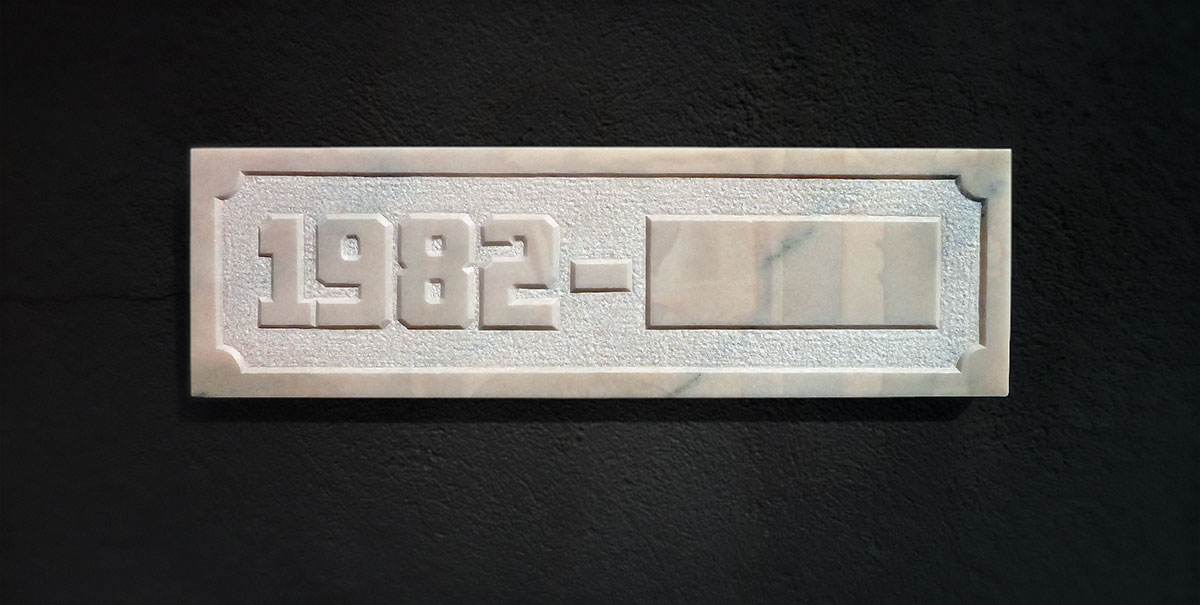SELF-PORTRAIT ( WE THE LIVING )
| “Painting is possessed of a divine power, for not only . . . does it make the absent present, but it also, after many centuries, makes the dead almost alive, so that they are recognized with great admiration . . .” |
| Leon Battista Alberti |
self-portrait ( We the Living ), marble, 50,8 x 15,5 x 1,8 cm., 2012.
While reminding us of the inexorability of death, this tombstone relegates it to the background. In fact, this is not a tombstone, it is art. Left forever unfinished, the marble slab makes allusion to denial mechanisms that kick-in when we face this final human experience. What really matters is not death, but the time that stands between the day of our birth and the day of our departure.
“Unlike most self-portraits, which are a faithful representation of the artist, a tombstone stands as the only clue to the author’s identity in the Self-portrait of Ciprian Homorodean. The marble slab destined to sit on top of the artist’s grave replaces the image of his likeness, substituting the human figure with a sign of its end. Encapsulating the artist’s life in the monument to his death offers an unusual perspective of the self-portrait, appearing more as an acknowledgement of the artist’s mortality than of his living image. Its message remains voluntarily inconclusive, however, almost inviting death to finish the portrait, or excluding it forever from the artist’s experience. Only one date is revealed, the year of his birth. On the opposite side, a blank space; the end date has been left in suspense. In fact, rather than a symbol of death, the work is its negation, at once invoking the magical powers of art and claiming eternal life for the artist.
Artists do transcended the mortal condition, immortalized by their works and by art history. This fate, however, is rather an exception in the highly competitive artistic environment of the 21st Century, a fact that this particular self-portrait does not fail to evoke.
Knowing that the stone was sculpted in 2012 situates the author in his late twenties, in the very latter part of his life as a young artist. This is a crucial moment in the life of most contemporary artists striving to live from their art. Most will establish their achievement during the early years, gaining the recognition of the art world that will guarantee their future as artists. Failure to do so seriously compromises the artists’ financial success, forcing sometimes a gradual abandonment of art in favor of more lucrative activity. It heralds the end of life as an artist. As it turns out, death in this case is not only a physical event. And this is not a portrait of the self, it is simply –and tragically- a real possibility. For artists and all other professionals alike.”
Artists do transcended the mortal condition, immortalized by their works and by art history. This fate, however, is rather an exception in the highly competitive artistic environment of the 21st Century, a fact that this particular self-portrait does not fail to evoke.
Knowing that the stone was sculpted in 2012 situates the author in his late twenties, in the very latter part of his life as a young artist. This is a crucial moment in the life of most contemporary artists striving to live from their art. Most will establish their achievement during the early years, gaining the recognition of the art world that will guarantee their future as artists. Failure to do so seriously compromises the artists’ financial success, forcing sometimes a gradual abandonment of art in favor of more lucrative activity. It heralds the end of life as an artist. As it turns out, death in this case is not only a physical event. And this is not a portrait of the self, it is simply –and tragically- a real possibility. For artists and all other professionals alike.”
Rose Marie Barrientos.
